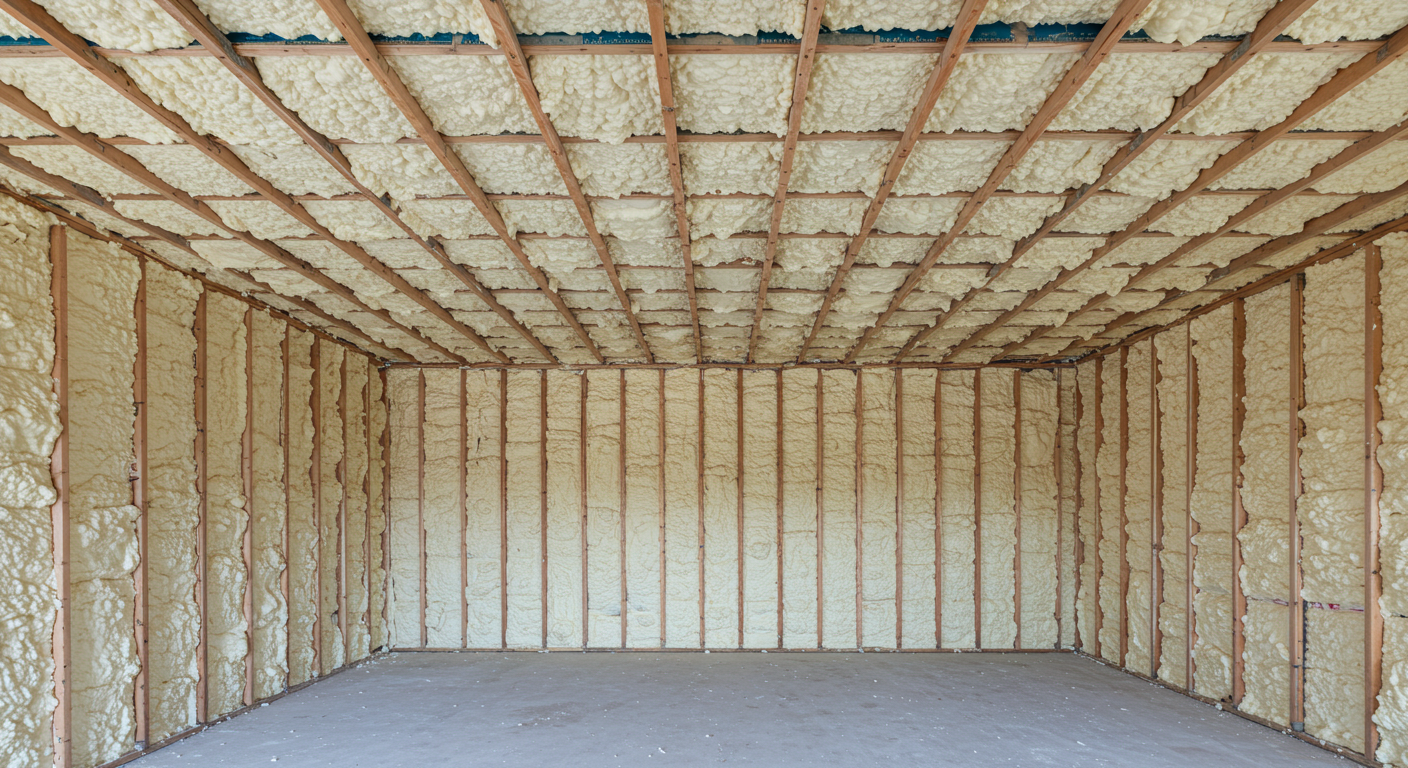At R-Factor Spray Foam, we’ve seen what happens when homeowners rush into insulation decisions without fully understanding the impact. Spray foam Insulation is one of the most effective insulation options on the market, but choosing it especially in a place like Hernando County comes with a few important realities you need to know upfront. Whether you’re trying to lower energy bills, reduce noise, or protect your home from Florida’s moisture-heavy climate, getting this decision right can make a real difference.
In this guide, we’re breaking down exactly what matters before you install spray foam insulation in Hernando County. We’ll answer the questions that don’t always get answered, cut through the noise, and walk you through the most practical, real-world factors to consider. From building codes to ventilation strategy, and from contractor red flags to what type of foam works best for Florida homes this is everything we think you deserve to know, directly from our experience in the field.
Know Your Building Structure And Its Needs
Every home has its quirks. Attics built without proper ventilation. Crawl spaces prone to moisture. Old framing that doesn’t cooperate with modern materials. We’ve worked in enough Hernando County homes to know: a one-size-fits-all approach never works.
Installing spray foam is as much about understanding your structure as it is about applying the insulation. Our team always begins with a detailed site assessment, checking for existing moisture problems, verifying construction type, and identifying areas where spray foam will perform best and where it may not be appropriate at all.
Assessing Structural Conditions Before Installation
A pre-install inspection can help uncover issues like air leakage points, outdated fiberglass batts, or signs of rot in the attic. We’ve seen homes where moisture had built up behind walls for years because no one had taken the time to properly assess the structure first. Catching these problems early avoids expensive surprises down the road.
Why Matching Foam Type to Structure Matters
Closed-cell foam is more rigid and moisture-resistant ideal for crawlspaces and areas prone to flooding. Open-cell, being more flexible and breathable, suits attic spaces where you want airflow and cost efficiency. Our team helps you choose the right foam based on real-world needs, not product hype.
Hernando County’s Climate Demands a Smart Insulation Strategy
Florida’s climate can feel like a sauna half the year. Heat, humidity, and sudden temperature swings mean your insulation needs to do more than just fill gaps. It has to actively work with not against your home’s thermal performance.
We’ve seen many homeowners in Hernando County surprised by how much difference proper insulation can make in energy bills and indoor comfort. But it only works if the installation takes our climate into account.
Dealing with High Humidity and Moisture Risk
Homes near the Gulf or in flood-prone zones benefit most from closed-cell spray foam. It acts as a moisture barrier, helping to protect against mold and water infiltration. We regularly install it under floors and behind walls in homes built close to waterways.
Energy Efficiency Gains in Florida Homes
Spray foam seals every crack, which dramatically reduces the amount of outside air that creeps into your home and that’s a game-changer for your HVAC system. Clients often tell us their air conditioning units cycle less frequently after installation, meaning lower utility bills and longer HVAC life.
Understand the Local Codes and Choose a Contractor Who Does
Spray foam isn’t just about product and technique it’s about compliance. Hernando County has specific codes related to fire protection, attic access, vapor barriers, and energy ratings. Getting this wrong can mean fines, failed inspections, and costly rework.
At R-Factor Spray Foam, we work directly with inspectors and stay current with local code requirements so our installations pass the first time. We don’t cut corners. If something needs fire-rated foam or ignition barriers, we tell you. Transparency upfront prevents problems later.
Permits, Fire Barriers, and Ventilation Standards
Spray foam in attic spaces must meet fire rating requirements, which often include applying thermal or ignition barriers. Some installers skip this step to save time we never do. We also factor in ventilation strategies to avoid creating air-sealed “dead zones” that trap moisture.
Choosing a Contractor That Works Locally
We live and work in Hernando County. That matters. We’ve built relationships with local inspectors, know which neighborhoods have soil that affects foundation insulation, and understand which homes are most vulnerable to humidity buildup. That local knowledge shows up in our work.
Don’t Overlook Ventilation It’s as Critical as Insulation
One of the most common questions we get: “If spray foam seals everything up, will my home still breathe?” It’s a smart question. The short answer: not unless it’s planned for.
Properly installed spray foam creates an airtight envelope. That’s great for energy efficiency, but it does change how air moves through your home. You may need to integrate mechanical ventilation or adjust your HVAC to maintain healthy airflow.
Attic and Crawlspace Ventilation Strategies
When we seal off attic spaces, we often recommend conditioning the attic as part of the HVAC system. This keeps temperatures stable and prevents moisture buildup. In crawlspaces, we sometimes add dehumidifiers or recommend ventilation systems to balance humidity.
When to Add Mechanical Ventilation
If your home already has poor airflow or relies heavily on passive ventilation, adding spray foam can make the issue worse. We advise clients on options like ERVs (Energy Recovery Ventilators) or dedicated exhaust systems to keep indoor air quality high.
Budget Wisely and Avoid Cheap Shortcuts
Installing spray foam is an investment. We won’t pretend it’s the cheapest option but it’s one of the smartest. And done right, it pays for itself over time. The key is understanding where it’s most effective and not wasting money on areas where it won’t matter as much.
We help clients prioritize. If your attic is the main culprit in energy loss, we start there. If your garage backs up to a conditioned space, insulating that shared wall might be more urgent than spraying the entire crawlspace.
How Long-Term Savings Offset Upfront Cost
Many of our clients see 20-40% reductions in their monthly energy bills after installation. Over five years, that adds up often covering the initial investment and then some. And because spray foam increases home resale value, it’s a win on all fronts.
Spotting Low-Quality Bids and Unqualified Installers
We’ve fixed enough bad installs to spot the warning signs early. Bids that seem too good to be true usually are. If a contractor doesn’t offer a detailed plan, skips moisture checks, or avoids local code discussions, walk away.
Your Path to a Protected Home Starts Now with R-Factor Spray Foam
Every home we insulate in Hernando County is different. We don’t just spray foam and walk away — we help homeowners make smart, lasting decisions that improve comfort, efficiency, and peace of mind. If you’re thinking about installing spray foam, don’t go in blind. Talk to a team that does this every day, understands your local environment, and tells you the full story.
Let’s make your home stronger, more efficient, and ready for Florida’s wild weather. Call (352) 663-5905 or email [email protected] to speak directly with our team. We’re here to help you make the smartest move for your home and your future.
Still Curious? Let’s Dive Deeper with R-Factor Spray Foam
What’s the best type of spray foam for Florida homes?
Closed-cell is ideal for moisture-prone areas like crawlspaces or exterior walls. Open-cell is more cost-effective and great for attics. We’ll help you choose based on your goals.
Does spray foam insulation really lower energy bills?
Yes. By sealing gaps and reducing air exchange, it lessens the load on your HVAC system. Most homeowners report noticeable monthly savings.
Will it make my house too airtight?
It can — which is why we plan ventilation carefully. We often recommend ERVs or other systems to maintain healthy air quality.
Do I need to leave my house during installation?
In some cases, yes — especially for larger projects or enclosed spaces. We’ll walk you through the schedule and safety steps in advance.
How long does installation take?
Most residential projects take one to two days, depending on square footage and access.
Can spray foam be applied over old insulation?
We usually recommend removing old insulation first to check for moisture issues or pests. We handle safe removal as part of our service.
Is spray foam safe for people and pets?
Once cured, yes. During application, we use protective equipment and ventilate the area to ensure safety.
How long does spray foam last?
Decades. Properly installed spray foam doesn’t sag, settle, or degrade like other insulation types.
Do I need a permit to install spray foam in Hernando County?
Yes, for most projects. We handle the permitting process and ensure everything’s up to code.
How do I get started?
Call us at (352) 663-5905 or email [email protected]. We’ll schedule a no-pressure inspection to assess your home and recommend next steps.


